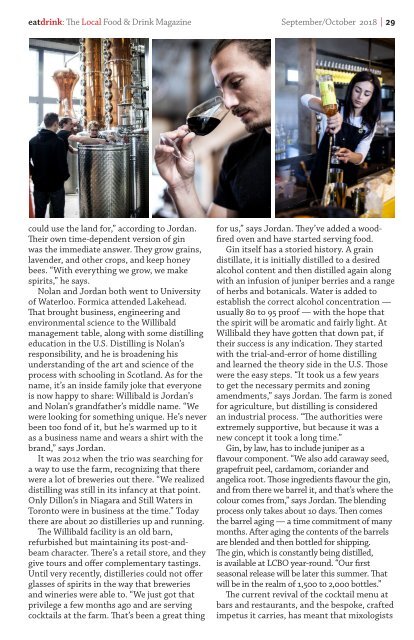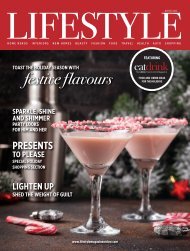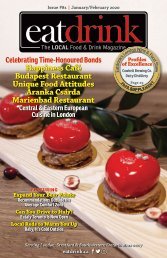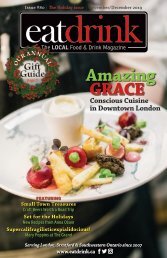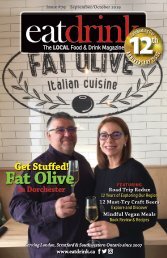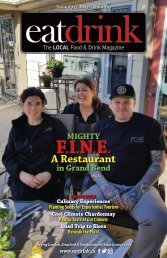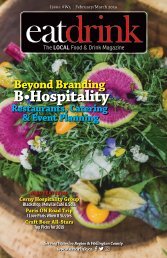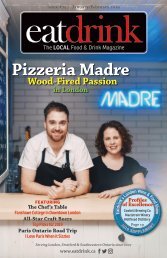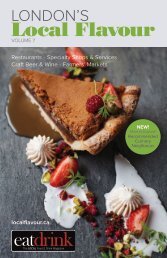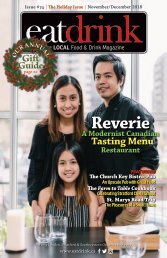Eatdrink #73 September/October 2018
The LOCAL food and drink magazine serving London, Stratford & Southwestern Ontario since 2007
The LOCAL food and drink magazine serving London, Stratford & Southwestern Ontario since 2007
You also want an ePaper? Increase the reach of your titles
YUMPU automatically turns print PDFs into web optimized ePapers that Google loves.
eatdrink: The Local Food & Drink Magazine<br />
<strong>September</strong>/<strong>October</strong> <strong>2018</strong> | 29<br />
could use the land for,” according to Jordan.<br />
Their own time-dependent version of gin<br />
was the immediate answer. They grow grains,<br />
lavender, and other crops, and keep honey<br />
bees. “With everything we grow, we make<br />
spirits,” he says.<br />
Nolan and Jordan both went to University<br />
of Waterloo. Formica attended Lakehead.<br />
That brought business, engineering and<br />
environmental science to the Willibald<br />
management table, along with some distilling<br />
education in the U.S. Distilling is Nolan’s<br />
responsibility, and he is broadening his<br />
understanding of the art and science of the<br />
process with schooling in Scotland. As for the<br />
name, it’s an inside family joke that everyone<br />
is now happy to share: Willibald is Jordan’s<br />
and Nolan’s grandfather’s middle name. “We<br />
were looking for something unique. He’s never<br />
been too fond of it, but he’s warmed up to it<br />
as a business name and wears a shirt with the<br />
brand,” says Jordan.<br />
It was 2012 when the trio was searching for<br />
a way to use the farm, recognizing that there<br />
were a lot of breweries out there. “We realized<br />
distilling was still in its infancy at that point.<br />
Only Dillon’s in Niagara and Still Waters in<br />
Toronto were in business at the time.” Today<br />
there are about 20 distilleries up and running.<br />
The Willibald facility is an old barn,<br />
refurbished but maintaining its post-andbeam<br />
character. There’s a retail store, and they<br />
give tours and offer complementary tastings.<br />
Until very recently, distilleries could not offer<br />
glasses of spirits in the way that breweries<br />
and wineries were able to. “We just got that<br />
privilege a few months ago and are serving<br />
cocktails at the farm. That’s been a great thing<br />
for us,” says Jordan. They’ve added a woodfired<br />
oven and have started serving food.<br />
Gin itself has a storied history. A grain<br />
distillate, it is initially distilled to a desired<br />
alcohol content and then distilled again along<br />
with an infusion of juniper berries and a range<br />
of herbs and botanicals. Water is added to<br />
establish the correct alcohol concentration —<br />
usually 80 to 95 proof — with the hope that<br />
the spirit will be aromatic and fairly light. At<br />
Willibald they have gotten that down pat, if<br />
their success is any indication. They started<br />
with the trial-and-error of home distilling<br />
and learned the theory side in the U.S. Those<br />
were the easy steps. “It took us a few years<br />
to get the necessary permits and zoning<br />
amendments,” says Jordan. The farm is zoned<br />
for agriculture, but distilling is considered<br />
an industrial process. “The authorities were<br />
extremely supportive, but because it was a<br />
new concept it took a long time.”<br />
Gin, by law, has to include juniper as a<br />
flavour component. “We also add caraway seed,<br />
grapefruit peel, cardamom, coriander and<br />
angelica root. Those ingredients flavour the gin,<br />
and from there we barrel it, and that’s where the<br />
colour comes from,” says Jordan. The blending<br />
process only takes about 10 days. Then comes<br />
the barrel aging — a time commitment of many<br />
months. After aging the contents of the barrels<br />
are blended and then bottled for shipping.<br />
The gin, which is constantly being distilled,<br />
is available at LCBO year-round. “Our first<br />
seasonal release will be later this summer. That<br />
will be in the realm of 1,500 to 2,000 bottles.”<br />
The current revival of the cocktail menu at<br />
bars and restaurants, and the bespoke, crafted<br />
impetus it carries, has meant that mixologists


